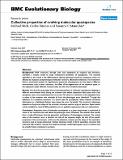Por favor, use este identificador para citar o enlazar a este item:
http://hdl.handle.net/10261/3406COMPARTIR / EXPORTAR:
 SHARE SHARE
 CORE
BASE CORE
BASE
|
|
| Visualizar otros formatos: MARC | Dublin Core | RDF | ORE | MODS | METS | DIDL | DATACITE | |

| Título: | Collective properties of evolving molecular quasispecies |
Autor: | Stich, Michael CSIC ORCID; Briones, Carlos CSIC ORCID; Manrubia Cuevas, Susanna CSIC ORCID | Fecha de publicación: | 9-jul-2007 | Editor: | BioMed Central | Citación: | BMC Evol Biol. 2007; 7: 110 | Resumen: | [Background] RNA molecules, through their dual appearance as sequence and structure,
represent a suitable model to study evolutionary properties of quasispecies. The essential
ingredient in this model is the differentiation between genotype (molecular sequences which are
affected by mutation) and phenotype (molecular structure, affected by selection). This framework
allows a quantitative analysis of organizational properties of quasispecies as they adapt to different
environments, such as their robustness, the effect of the degeneration of the sequence space, or
the adaptation under different mutation rates and the error threshold associated. [Results]We describe and analyze the structural properties of molecular quasispecies adapting to different environments both during the transient time before adaptation takes place and in the asymptotic state, once optimization has occurred. We observe a minimum in the adaptation time at values of the mutation rate relatively far from the phenotypic error threshold. Through the definition of a consensus structure, it is shown that the quasispecies retains relevant structural information in a distributed fashion even above the error threshold. This structural robustness depends on the precise shape of the secondary structure used as target of selection. Experimental results available for natural RNA populations are in qualitative agreement with our observations. [Conclusion] Adaptation time of molecular quasispecies to a given environment is optimized at values of the mutation rate well below the phenotypic error threshold. The optimal value results from a trade-off between diversity generation and fixation of advantageous mutants. The critical value of the mutation rate is a function not only of the sequence length, but also of the specific properties of the environment, in this case the selection pressure and the shape of the secondary structure used as target phenotype. Certain functional motifs of RNA secondary structure that withstand high mutation rates (as the ubiquitous hairpin motif) might appear early in evolution and be actually frozen evolutionary accidents. |
Descripción: | This article is available from: http://www.biomedcentral.com/1471-2148/7/110 | URI: | http://hdl.handle.net/10261/3406 | DOI: | 10.1186/1471-2148-7-110 | ISSN: | 1471-2148 |
| Aparece en las colecciones: | (CAB) Artículos |
Ficheros en este ítem:
| Fichero | Descripción | Tamaño | Formato | |
|---|---|---|---|---|
| picrender.pdf | 462,56 kB | Adobe PDF |  Visualizar/Abrir |
CORE Recommender
PubMed Central
Citations
14
checked on 16-abr-2024
SCOPUSTM
Citations
35
checked on 19-abr-2024
WEB OF SCIENCETM
Citations
30
checked on 29-feb-2024
Page view(s)
414
checked on 23-abr-2024
Download(s)
195
checked on 23-abr-2024
Google ScholarTM
Check
Altmetric
Altmetric
Artículos relacionados:
NOTA: Los ítems de Digital.CSIC están protegidos por copyright, con todos los derechos reservados, a menos que se indique lo contrario.
